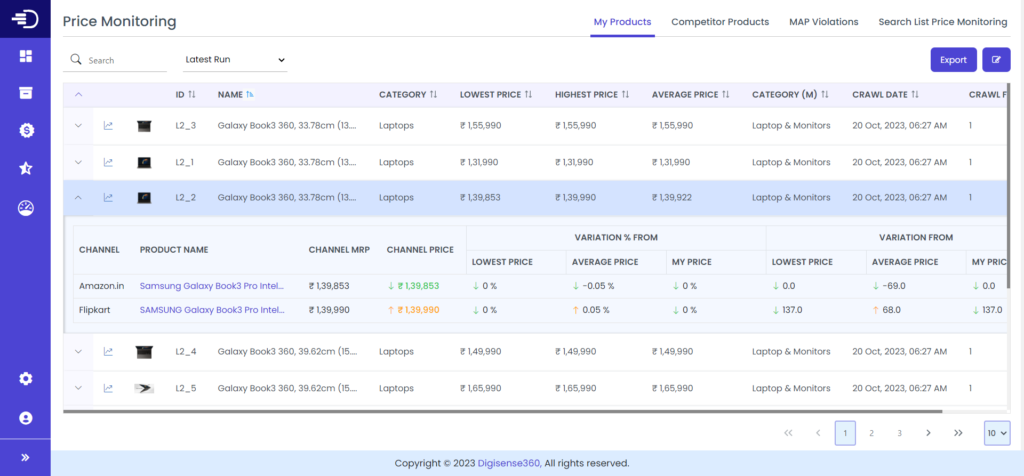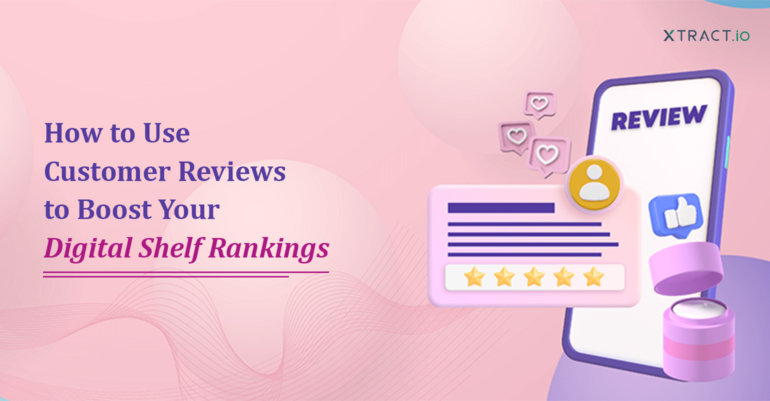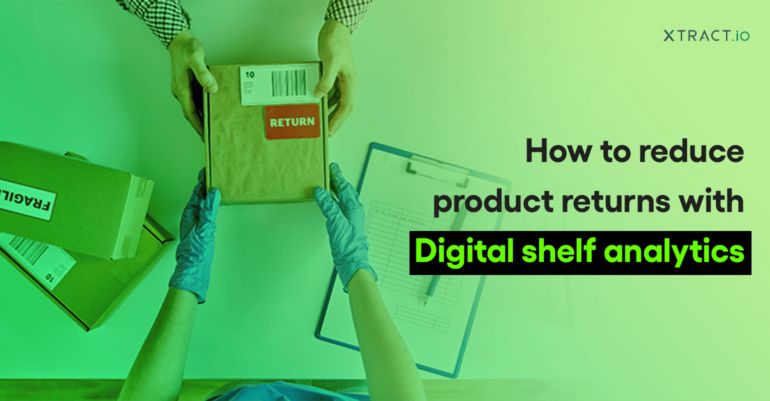It is no secret that eCommerce expects to reach unmatched sales growth in the next five years. This has led more brands to focus on the critical aspect of their ecommerce strategy, Digital Shelf analytics.
A digital shelf is a virtual space businesses use to display products and sell online. With diverse touchpoints and fast-changing trends, consumers’ shopping experiences are ever-evolving, creating more complex challenges for brands to keep up. It is increasingly vital for brands to navigate those challenges to increase sales across multiple channels and marketplaces.
Digital shelf analytics helps brands understand and lead the growing opportunities of online and offline realms with a data-driven approach. In this blog post, you will explore five ways to improve eCommerce strategy using digital shelf analytics.
The role of digital shelf analytics in ecommerce strategy
The digital shelf has become increasingly indispensable in recent years, especially with more and more customers shopping online. Since the customers make their purchases on the digital shelf, it can significantly impact ecommerce sales.
A well-designed digital shelf can attract and retain customers, while a poorly designed one can lead to a loss of sales and a damaged brand reputation. Therefore, it becomes essential for an ecommerce business to understand its digital shelf performance and how it affects the overall strategy.
By harnessing insights into digital shelf performance, brands can quickly identify growth opportunities, optimize their product listings, and improve the customer experience. Businesses should consider investing in an ecommerce intelligence platform. An ecommerce intelligence platform allows businesses and retailers to collect and analyze data from multiple sources, including the digital shelf, social media, and marketplaces.
A vital advantage of employing an ecommerce intelligence platform is its ability to aggregate data from multiple sources into a centralized system. This streamlines data analysis and uncovers trends across diverse channels.
1. Analyze product visibility and search rankings

Prioritize SEO for online presence
Having SEO-optimized product pages can increase product visibility to online shoppers. This improves the likelihood that potential customers will find and purchase the items. To optimize the product for online visibility, it’s essential to:
- Identify the top-performing keywords and search terms that match the products.
- Use these keywords in product titles, descriptions, image file names, and other metadata fields.
- Ensure the website is mobile-optimized and has a quick loading.
Optimize visibility on online marketplaces
Besides optimizing the website for search engines, focusing on visibility in online marketplaces such as Amazon, eBay, and Walmart is also essential. Each marketplace has its own algorithms and ranking factors, so it’s crucial to tailor the approach to each platform accordingly. Strategies for increasing visibility on marketplaces include:
- Optimizing product listings with relevant keywords and engaging product descriptions.
- Classifying the products under the appropriate categories and subcategories in each marketplace.
- Monitoring and improving product ratings and reviews.
2. Leverage data-driven decision making

Evaluate the digital shelf performance
Monitoring and optimizing your digital shelf based on insights from the KPIs helps identify opportunities to strengthen digital shelf performance, boost sales, and build a loyal customer base. The regular analysis provides metric-based indicators to navigate strategic ecommerce decisions. Some important indicators include:
- Conversion rate: A higher conversion rate indicates that the digital shelf converts traffic into sales. Low conversion signals issues preventing shoppers from buying that must be addressed.
- Average order value: Useful for optimizing pricing and promotions to increase spending per sale.
- Bounce rate: A high bounce rate points to problems with user experience, content, or other issues that frustrate customers and require immediate action.
Monitor the competitors and the market
Digital shelf analytics allows companies to track competitors’ metrics and pricing, making timely decisions to match or beat their performance. Keeping a close watch on competitors’ conversion rates, traffic, sales numbers, and pricing strategies helps businesses make data-driven choices to optimize performance. This includes:
- Identifying emerging opportunities and shifts in consumer behavior is also key to gaining a competitive advantage.
- Routine analysis of competitors provides benchmarks to measure against and determine where improvements must be made to surpass their results.
- Tracking market trends and changes in customer preferences signals new prospects to capitalize on and risks to mitigate before competitors react.
3. Focus on product content and imagery

Optimize product descriptions and images
Digital shelf analytics can help you identify the gaps in product descriptions and images. Ensuring high-quality content to drive engagement and conversions on the digital shelf. To optimize the product content:
- Ensure that product titles and descriptions are accurate, SEO-friendly, and in channel-compliant formats.
- Employ high-quality, multi-angle product images to display key product features.
- Incorporate additional visual elements, such as videos, 360-degree images, or interactive tools, to provide a more immersive shopping experience.
Maintain consistency across all channels
Digital shelf analytics can help maintain product content and imagery consistency across all online touchpoints, including websites, marketplaces, and social media channels, which is essential. This cultivates brand familiarity and credibility, enabling a frictionless customer purchasing journey.
4. Optimize pricing and promotional strategies

Implement dynamic pricing strategies
Developing a dynamic and agile pricing strategy that adapts to market changes and competitors’ moves is essential to attract shoppers. Digital shelf analytics can monitor competitor pricing across their sales channels, which helps businesses identify optimal pricing for the products, maximizing profits while maintaining a competitive advantage. This includes
- Utilizing data analytics tools to monitor market price changes and analyze customer behavior.
- Pricing rules can be set based on seasonality, inventory levels, and customer purchases.
- Offering personalized pricing based on their behavior, purchase history, or preferences.
Promotions and coupons
Promotions and coupons are powerful tools for driving sales and attracting new customers. To optimize the promotional strategies:
- Analyze historical data and industry trends to identify the most effective types of promotions for specific products and target audiences.
- Ensure promotions are well-timed and aligned with seasonal trends or key shopping events.
- Utilize digital shelf analytics to measure the impact of the promotional campaigns and make adaptive decisions as needed.
5. Enhance the positive brand image

Improve the customer experience
A seamless, engaging customer experience yields higher conversion rates and brand loyalty. Optimizing the digital journey involves:
- Design websites to be intuitive to navigate and optimize product searchability.
- Optimize product pages with engaging content and high-quality images.
- Implement clear and simple checkout processes.
- Provide flexible payment and shipping alternatives tailored to diverse customer needs.
Monitor customer ratings and reviews
Monitoring customer reviews and product ratings is critical to identify key improvement areas and enhance the customer experience. Digital shelf analytics can help you track customer reviews and ratings, allowing businesses to address issues and improve based on real customer insights. This includes
- Performing sentiment analysis to help businesses gauge overall customer attitudes and feelings.
- Ensuring both the positive and negative customer feedback are addressed timely.
- Leverage user-generated content to build brand impact and a positive reputation.
Implementing a data-driven ecommerce strategy with DigiSense360
To effectively implement a data-driven approach to ecommerce strategy, businesses should adopt an ecommerce intelligence platform that helps them set up metrics for digital shelf success. This includes setting up clear goals and key performance indicators (KPIs) that allow businesses to track progress toward these goals.

Robust digital shelf analytics like DigiSense360 enable digital shelf optimization for businesses to adjust strategies to suit market changes. DigiSense360 encompasses the entire view of the digital shelf performance in the dashboard so businesses can focus on optimizing the strategies backed by ecommerce intelligence.
Businesses and retailers use DigiSense360 to monitor competition, pricing, and channel performance, conduct content audits, and analyze customer reviews and ratings to maximize sales. The analytics platform gives businesses 360-degree insights into digital shelf performance to fuel their ecommerce strategy.
Like to know how to implement digital shelf analytics for your business? Learn more about DigiSense360 from our demo.







